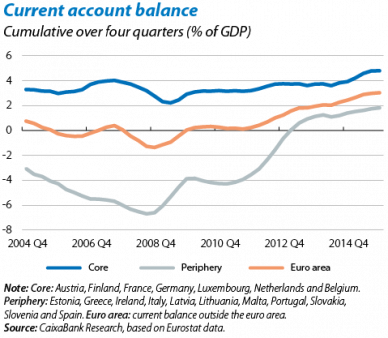After the start-up of the euro, the current account balance of the euro area remained at equilibrium. However, in 2011 it began an upward trend which brought it to 3% of GDP in 2015. In this Focus we analyse the key factors behind this change in trend in order to determine to what extent they are temporary.
The trend of the current account balance by country provides the first clue as to the factors pushing up the current balance of the euro area as a whole. It can be seen that the peripheral countries experienced large deficits before the crisis which they sharply corrected between 2008 and 2015 until achieving a surplus of 1.8%. This contrasts with the situation in the core countries which, after the euro came into circulation, have maintained a considerable current account surplus that has remained relatively stable and has only increased slightly in the last year. The change in the euro area's current account balance is therefore due particularly to the correction taking place in the periphery.
There are many factors lying behind this correction in the peripheral countries. Firstly, the moderation in domestic demand between 2008 and 2012 helped to improve the current account balance by reducing imports. Part of this moderation was temporary and has been reversing since 2013. However, another significant part was structural as growth in domestic demand is expected to be lower than that observed before the crisis.1 This fact has reduced the current account imbalances.
The improved price competitiveness of exports has also helped to boost the current account surplus. This increase in peripheral competitiveness is largely due to a reduction in the countries' unit labour costs compared with their rivals,2 a correction which is above all structural as it is partly due to the labour reforms that have been carried out, making the peripheral economies more flexible. On the other hand the euro's depreciation was a cyclical factor that also helped to improve the price competitiveness of exports to countries outside the euro area. Although this factor is the same for all countries in the euro area it particularly benefits the periphery as their exports are more sensitive to exchange rate variations since they compete more in terms of price and less in quality.3
Lastly, the drop in oil prices has also helped to improve the current account balance for energy of the euro area (in 2015 this represented an improvement in the trade balance of 0.7% of GDP).4 Insofar as part of the reduction in the price of crude is permanent in nature, being linked to a larger supply resulting from the exploitation of unconventional reserves such as shale oil, the improvement in the energy balance can also be seen as permanent. Another part is, however, temporary and the recovery in oil prices will reverse some of the improvement seen in the current account balance.
The factors analysed therefore point to a significant proportion of the improvement in the current account balance being due to structural factors. This has also been confirmed by a study carried out by the European Commission, which precisely suggests that the improvement in the current account surplus occurring in the euro area as a whole between 2007 and 2015 (3.1 pps of GDP) is totally due to structural factors.5 It also concludes that structural improvements have been particularly marked in the peripheral countries, a phenomenon worthy of applause and whose consolidation must be safeguarded, given that these economies have a high net external debt. On the other hand the core countries, which are generally posting limited growth rates, could promote reforms to improve growth in their domestic demand, although this might reduce their current account surplus.
1. European Commission «European Economic Forecast, Spring 2015».
2. For example, in Spain ULC were in 2015, 3.8% lower than the figure for 2008, while in Germany they were 19.3% higher.
3. Between March 2014 and April 2015, the nominal effective exchange rate depreciated by 13%. The 5% appreciation posted between April 2015 and March 2016 has partially reversed this trend, showing the importance of structural gains in competitiveness.
4. IMF «2015 External Sector Report - Individual Economy Assessments».
5. European Commission «European Economic Forecast, Spring 2015».
